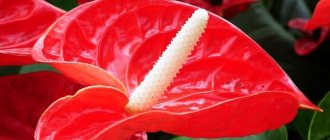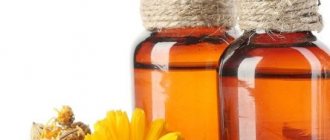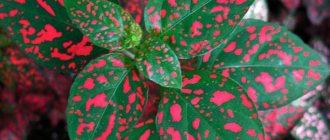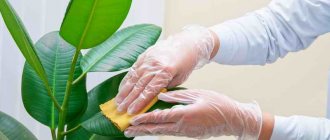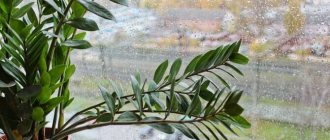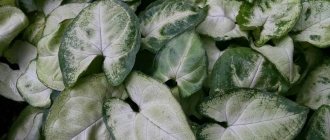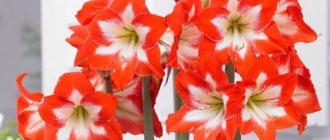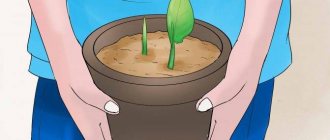Possible problems in growing birch trees
It is easy to determine why certain metamorphoses occur with roisissus, since the plant reacts to changes in the microclimate of the room.
What diseases and parasites can affect a flower:
- Lack of humidity often leads to the appearance of fungal diseases that can affect the above-ground and underground parts of the specimen.
- Poorly disinfected soil can become the basis for the appearance of scale insects and dust mites.
- If the leaves begin to dry, then infection with root rot is possible. This problem occurs if the substrate does not allow air to pass through, there is no drainage and excess water stagnates in the pot.
- A frequent “guest” is powdery mildew. But the disease can only affect plants that are weakened after a sharp temperature change.
Diseases of indoor birch
Crohn's can be treated with a soap solution against any type of parasites and infections, but if the form of the disease is not advanced. If this does not help, then special means must be used to combat the disease.
The decorative version of roisissus is an ideal option for breeding by inexperienced gardeners who want to decorate their home with a floral arrangement. An ideal option for such a plant would be a house with “tropical” climate conditions. The plant does not require special care; it reproduces using the elementary method.
Diseases and parasites
Caring for a birch tree at home is not difficult, but if you do not follow the listed rules, this will lead to the flower starting to hurt or various pests appearing. Despite the fact that this crop is unpretentious, it can suffer from various diseases and parasites.
An example is the spider mite. It appears on a birch tree and begins to parasitize only if the flower was not properly cared for, for example, when watering was irregular and rather meager. As a result, the finest cobwebs gradually appear on the branches and leaves. To combat this pest, it is recommended to use insecticidal preparations. In addition, all rules must be followed.
Scale insects also attack indoor plants because care rules are not followed. But the plant will quickly recover after special treatment, regular watering and loosening of the soil.
Aphids can also damage a birch tree. They get rid of it using different methods. For example, you can use special preparations for spraying bushes. A soap solution is also suitable (use only laundry soap), to which a small amount of ordinary wood ash is added.
One of the diseases is root rot, which develops due to improper care. The plant gradually withers, withers, and leaves fall off. In this case, you need to carefully remove the shrub from the container, cut off the diseased roots, treat them with ash or charcoal, and then transplant them into a new container. Be sure to fill it with fresh soil.
Another dangerous disease is powdery mildew. It appears on birch foliage in the form of a whitish coating. Gradually the bush fades. To combat this disease, it is recommended to use the special drug “Topaz”.
Most often, the leaves of the birch tree begin to dry out and fall off. This is due to a number of factors:
- Excessively dry air. This can be corrected by frequently spraying the flower with a spray bottle.
- Root rotting. In this case, the plant must be replanted.
- Seasonality. Leaves may fall off in autumn.
- Draft.
- Lack of oxygen to roots. This is due to the fact that the soil is excessively dense. In this case, it should be loosened the next day after watering.
If you have not yet decided which flower to keep at home, then this is, of course, roisissus, because it will decorate any wall. In addition, it is completely unpretentious, so it does not require special care. But you shouldn’t believe in various signs, as this plant will only decorate your home!
Features of care
Why violets don't bloom
Caring for a flower is not particularly difficult; all the techniques are standard.
Watering requirement
Even novice plant growers can care for a birch tree at home. The flower needs periodic irrigation. You should not overdo it with moisture; it is recommended to water only when the top layer of soil dries out.
To irrigate the flower, you must use settled water at room temperature. It is advisable to use filtered liquid, where the content of harmful chlorine is practically reduced to zero. If after water procedures liquid appears in the pan, then it must be drained and the soil in the pot loosened (top layer).
Feeding
As for nutritional compositions, it is effective for house plants to use a complex fertilizer intended for decorative deciduous crops. If there is a lack of useful components in the soil of a climbing plant, all growth processes are suspended and its decorative properties are lost.
The frequency of feeding procedures is once every two weeks; they must be done at the active growing season of the birch tree. In winter, when it is dormant, there is no need to add food until the beginning of March. Fertilizers are allowed to be added to the soil only when the room temperature is above 20 °C. If the temperature in the room is below 20 °C, then the frequency of use of nutritional compositions is once every 30 days.
Pests and diseases
If care is not taken care of, the indoor birch tree can be affected by diseases and parasitic individuals. Decorative culture is often attacked by:
- Spider mites and scale insects. Harmful insects appear on ornamental crops with irregular and poor watering. The mite can be detected by the presence of a thin web on the branches and leaves of the plant. To destroy parasites, it is necessary to treat with an insecticidal preparation. To quickly restore the flower, you need to set up a watering system and loosen the soil in the pot.
- Small aphids. It is effective to use special products such as Actellica and Fitoverma against the pest. Among the traditional methods, a soap solution works well, in which, in addition to crushed laundry soap, there is also wood ash.
Improper care also often provokes the development of root rot, which leads to withering of the plant and premature loss of leaves. To save a flower, you need to carefully remove it from the flowerpot, remove damaged parts of the root system, treat the wound surface with crushed charcoal, and replant it in new soil.
If a whitish coating was found on a green pet, and it began to noticeably wither, then it was affected by powdery mildew. It is effective to combat this disease using a working solution based on Topaz.
Features of caring for birch trees at home
Experienced breeders claim that there will be no problems with growing roisissus. Some compare the plant to a domestic “pet” that loves to “eat” and “bathe”.
The birch tree is a house plant; its care is carried out according to the simplest scheme of watering, soil treatment, lighting and setting the temperature regime.
Roisissus pot
The container for growing the plant must be spacious and stable, and it will have to be changed quite often, since the roiscissus grows very quickly. When the diameter of the pot reaches 30 cm, the plant can no longer be replanted, but only annually update the top layer of soil.
Lighting
The plant loves light, but it is better to place the pot on windowsills on the western or eastern side. The north side is also suitable, but the flower will grow very slowly. Direct sunlight can damage the foliage - the light should be slightly diffused.
Ideal window sill for roiscissus
Temperature
It is important to set the temperature correctly for normal growth and development. You can keep the specimen in a room where the temperature is:
- in summer it will be +20, +25 degrees;
- in winter - +15 degrees, +20 degrees.
The plant can normally survive sharp drops in temperature down to +5, but this can lead to the manifestation of various diseases.
Watering and air humidity
Frequent and abundant watering is a necessary condition for maintaining a birch tree. In this case, soft water is used, since roisissus does not like lime.
In winter, the plant needs to be watered much less often, but only when kept in a cool room.
If the room is hot, then the frequency of watering should be the same as in summer.
A native of tropical forests, rhoicissus loves high air humidity.
In summer it needs to be sprayed regularly. This procedure is also important for cleaning leaves from dust.
ATTENTION: When determining watering rates, consider what pot the birch tree is grown in. Ceramic pots allow water to pass through and actively evaporate it, so the plant should be watered more often.
In a plastic pot there is a risk of soil becoming waterlogged, since the water does not evaporate from it. Excessive watering of the soil in such a pot risks rotting the root system.
During watering, fertilizers must be added to the water every two weeks. Any universal mixtures for indoor decorative foliage plants sold in retail outlets are suitable.
You can feed it with drinking tea and infusion of chamomile. They also contain some nutrients.
IMPORTANT: If there is a lack of nutrients in the soil during cultivation, the roisissus slows down its growth and begins to turn yellow.
Spraying
Roicissus loves it when the leaves are sprayed. You can even arrange weekly baths.
Transfer the plant to the bathroom and rinse each leaf with water at room temperature.
Soil and transplantation rules
After purchasing, the birch tree should be immediately freed from the transport substrate and transplanted into a new pot.
If the root system is completely entangled in the earthen ball, then select a pot 5-6 centimeters larger than the store-bought one.
Unlike other plants, rhoicissus does not require time to acclimatize; it tolerates changing conditions and any transplantation well.
Roicissus prefers loose nutrient substrates, the basis of which is turf and leafy soil. You can add humus to the mixture, one part to 2 parts turf and 2 the same amount of leaf soil. For looseness, one part of sand or peat-sand mixture is also added.
TIP: Replanting is necessary annually for plants aged 2-3 years; upon reaching the age of three, it is reduced to once every two years.
During the growth period, when transplanting rhoicissus, the pot is taken 3-4 centimeters larger than the previous one. Be sure to install drainage to prevent the plant from flooding.
Priming
The soil should be light and well breathable. Therefore, after watering, it is advisable to ruffle the top layer of soil. It is enough to pick the ground with a stick.
To avoid problems with moisture stagnation and blooming of the top layer, you need to choose the right composition, mixing in equal parts:
- turf land;
- leaf soil;
- humus;
- coarse sand.
Substrate preparation
To avoid additional problems with the soil, you should choose a ceramic pot for growing.
Step-by-step transplant process
- We carry out replanting using the transshipment method, which causes the least amount of trauma to the roots.
- We lower the plant into a prepared pot, at the bottom of which a 3 cm layer of drainage is laid, soil is poured and a support is secured.
- Cover the plant with soil mixture. In order for the soil to be evenly distributed between the roots and compacted, we periodically spill it with water.
- After transplanting, we move the plant to its usual place.
Crown formation
The splendor of the bush gives the birch a special decorative appearance.
TIP: In order for a dense crown to form and the plant to produce numerous lateral shoots, it is necessary to regularly pinch out the longest stems.
Trimming
Homemade birch in a pot is an ideal plant option for those who like to experiment and create. Thanks to pruning, you can form a crown.
Branches that have become partially bare, shedding their foliage, as well as unsightly growing parts of the shoots, must be removed. You can remove those parts of the crown that do not fit into the shape of the plant. It is not advisable to remove many parts at the same time.
The procedure is carried out as follows:
- Prepare tools: sharp pruning shears, activated carbon powder.
- Identify items that require removal.
- Cut the shoots with pruning shears, making 1 precise cut.
- Treat affected areas with activated carbon powder or plant antiseptic.
Important ! The procedure should be carried out in early spring, before the specimen enters the active growth phase. If necessary, you can do pruning in the summer, but in smaller quantities.
Fertilizing for "birch"
Despite its status as a fast-growing plant, rhoicissus requires fairly moderate feeding. Fertilizers are applied only from March to the end of October, and are completely stopped during the winter period. For this plant, it is better to use complex fertilizers for decorative foliage plants containing microelements. The optimal frequency of feeding is once every 2-3 weeks.
How to fertilize correctly
The most intensive growth of the birch tree occurs in the summer, so it needs additional nutrition at this time of year. Fertilizing is done with universal complex fertilizers for houseplants approximately once every 2-3 weeks. In addition, in spring and summer, a complex agent for growth and increase of green mass is added to the spraying water. It is also used once every 2-3 weeks. It is important to know that you cannot fertilize and spray with water and the preparation at the same time, as this can cause burns on the foliage and roots.
Bloom
In nature, cissus blooms readily and even bears fruit. At home, this is an extremely rare occurrence. Although it happened that with proper care, the Antarctic cissus presented a surprise and pleased the owners with, albeit modest, flowering.
Cissus bloom does not attract attention
Rest period
Cissus does not have a clearly defined period of rest. Even in winter, the plant is able to develop, although not as actively as in summer. There is no need to create any additional conditions during the cold season. It will be enough to limit watering and stop feeding.
Recommendations for propagating rhoicissus
Why do orchids have limp leaves, what to do in such a situation?
You can get a new plant by dividing the bush, cuttings and planting seeds. Any time of the year is suitable for this operation, but the end of winter or March is preferable. For cuttings, select the apical stem and cut the branch so that it has a certain number of buds (3–4 nodes). It is placed in a pot with a peat-sand mixture and covered with polyethylene. Rooting takes place at a temperature of about 20 degrees, and do not forget to ventilate and moisten the soil. After about 3 weeks the plant will take root. You can also wait for the roots to appear if the cutting is placed in water
As soon as it is clear that the roots have appeared, the cuttings are planted in a pot with a diameter of 8 cm, with the usual substrate for the plant. During transplantation, you can divide the bush into several parts; it is important that the part has a sufficient number of root shoots. The root system is carefully separated
The parts are planted in moist soil, which is suitable for permanent growth. The main thing is not to expose the roiscissus division to sunlight; it is necessary that rooting and adaptation take place in partial shade. As soon as the plant confidently begins to grow, it can be placed in a permanent place. Having sowed seeds in a substrate, there is no chance that they will be able to germinate indoors. And since, at home, this plant practically does not bloom, and its seeds are very rare in stores, it is better to propagate roisissus using the methods described above. To give the desired appearance to a “birch tree”, regular pruning of its shoots is necessary. This will help not only make the bush thicker, but also give it the chosen shape. Every spring, when inspecting the roisissus, if too bare, thinned or dried out branches appear, they are cut off almost to the stumps. "Birch" requires good support for growth. It is best to choose special reliable ladders or trellises along which the plant will climb. With the help of roisissus shoots, you can create phytowalls and green screens, but it is necessary to guide the vine stems by combining pruning and staking of the plant.
Seeds
- From April to May they are sown in flat round pots, planted shallowly in the ground.
- The bowls are covered with a plastic bag.
- Ventilate and keep moist.
- When the sprouts have a pair of leaves, they are planted in separate pots.
The conditions for the growth of young plants are the same as for adults.
Seeds can also be germinated in peat tablets
Cuttings
Propagation using cuttings is perhaps the most popular method. Moreover, the cuttings take root well both in water and in soil mixture.
- To obtain a new plant, use a sharp knife to cut a cutting 10 cm long with several leaves.
- In a small (8 cm) pot filled with a sand-peat mixture, 3 or 4 cuttings are planted at once.
- The planting container is covered with a glass jar or bag and kept at a temperature of 20 to 22 ° C and at high humidity.
- After 3 weeks, roots appear and the plants are planted in separate pots. But you can plant several rooted plants in one container. And then it will grow more magnificent.
You can propagate using cuttings at any time of the year, but preferably in spring or summer.
Dividing the bush
This method is used in the spring, when transplanting an overgrown plant into a new container. The roisissus removed from the pot is divided very carefully into the required number of parts, each of which must have a formed root system and an adult shoot.
This way the plant can be divided when replanting.
Immediately after division, each part is planted in a separate prepared pot.
By layering
Roicissus can be propagated using layering at any time.
- Select an adult healthy shoot, which is fixed in a nearby pot in suitable soil.
- As soon as the rooted shoot has grown a root system, it is cut off from the mother plant.
Roicissus can also be propagated by layering
Possible problems in growing birch trees
Thuja indoors
Why does the plant begin to wither and dry out? The reason is improper care and maintenance. The plant must be constantly inspected for the presence of pests. Problems that gardeners may encounter:
- The leaf blade becomes deformed and dries out. The reason is dry air in the house; to correct the problem, just humidify the air around the flower.
- The leaves turn pale and fall off. This is due to high temperature. Place the pot with the birch tree in a cool room. In summer, the flower can be taken out into the fresh air.
- Brown leaves appear due to too humid air and constantly wet soil. Do not water the flower until the soil has dried two centimeters.
- Abundant shedding of foliage is the result of the flower being in a draft and in a cold room. The situation can be corrected by normalizing the temperature.
- Leaves fade due to lack of minerals. Adding nitrogen will return the birch leaves to their original color.
- Stunted growth is associated with a cramped pot. Transplanting the rhoicissus into a larger pot will provoke the appearance of new branches.
If the maintenance is poor, the flower may get sick and be spoiled:
- Gray rot. Gray mold forms on the leaves, then the leaf begins to rot. This happens due to waterlogging of the soil. Diseases can be controlled using fungicides.
- Spotting. It is manifested by the formation of dead areas on the leaves. Unlike fungal spots, bacterial spots have clear contours. Three sprays are carried out with a 1% solution of Bordeaux mixture.
- Spider mite. The plant is covered with a thin web. White-yellow blotches are visible on the leaf. To destroy the pest, the leaves are washed with soapy water, and then the preparations Actellik and Fitoverm are used.
- Greenhouse aphid. The insect is dangerous because it sucks the juice from the plant. The leaves turn orange, then curl and fall off. The drugs Actellik and Fufanon are used against aphids.
Important! Birch is a wonderful indoor plant, which is used as decoration and decoration of the room. It does not require special care, so it easily takes root in offices, educational institutions, and technical rooms.
Popular birch varieties for growing at home
Antarctic cissus is a species with entire, serrated, ovate leaves. It tolerates shaded corners of the room well and clings to the support with the help of antennae. The reverse side of the foliage has red pubescence. This species does not tolerate dryness in winter and too high temperatures, as well as shading.
Cissus rhombifolia is a species with beautiful carved foliage, the leaf blade is tripartite. Often grown in pots without direct sunlight. The length of the lashes increases to 2 m over the season.
"Ellen Danica" is a flower with beautiful dissected leaves.
Cissus multicolored is a species that does not like temperature changes and direct sunlight. The front part of the leaf plate has beautiful white stripes, the back side is purple. The plant needs support. This species tolerates shade well.
Cissus cactus is a rare indoor species with thickened shoots that clings to support with tendrils.
Cissus rotundifolia - leaf plates are ovoid in shape with a serrated edge.
What kind of flower is this - indoor birch
The indoor birch flower has the scientific name roicisus. It is one of 350 varieties of grapes. The plant has thin long stems, as well as a strongly curly crown. The average size of a birch tree varies from 50 cm to 1 m.
The birch tree is ideal for placing in a hanging pot. Another important advantage is that the pot can be placed deep in the room; it does not need direct sunlight. The pot can be located near the sofa, at the entrance to the room or on the wall.
In order for your home plant to delight you with its beauty and rich green color, you need to follow simple rules for caring for it.
Folk signs about health benefits and harms
There are many folk signs and beliefs associated with the birch plant. Many people, having heard enough, begin to doubt whether it is possible to keep it at home.
Some are sure that roisissus is a muzhegon, that is, a man can leave the house where it grows. All these signs are far-fetched, since birch trees can be found in those houses where spouses have been living together for many years and the husband has no plans to leave. So, the vine will not cause anything bad to people and you can safely keep it at home.
Recently, birch has become very popular, as a new interpretation has appeared that it improves immunity, inspires a person to new ideas and normalizes the atmosphere in the house.
This news was confirmed by scientists. Studies have shown that birch not only decorates the room, but also improves air quality, it becomes cleaner and more humid. It can also absorb harmful substances from the air.
Home flower birch: signs
There are some superstitions and signs associated with the birch houseplant. People believe that this flower brings men out of the house. There is no exact evidence of this, but still many do not risk having this flower in their home. Everyone has their own opinion on this matter. Some of them are shown below.
Oksana, 30 years old, writes: “I am of the opinion that it is undesirable to keep a birch tree in the house. I think that all this is not fiction. I no longer keep this plant in my living space; I threw it out a long time ago. And I must say that my personal life has improved. I don’t know, naturally, maybe it all coincided like this, but I don’t want to take risks anymore.” Milana, 35 years old, writes: “ birch tree
- a harmless plant, it is also worth saying that it is very unpretentious and quickly grows larger.
Will cope perfectly with gas pollution. I don’t think that this beautiful plant can have a bad influence on family relationships.” Lena, 27 years old, writes: “if you believe in omens, then they will definitely come true. My family grew several similar birch trees. They grew magnificently and beautifully, but in our house we had a woman’s monastery. The men didn’t stay in the family for long until we put the cissus in the entrance.” Tatyana, 29 years old, writes: “I once had a birch tree growing, but not so long ago it withered. I believe that this flower cannot keep men out of the house. My mother-in-law has had this plant for decades. Not paying attention to this, she lives with her father-in-law for 40 years in perfect harmony. My husband and I are doing great too.” Home
flower birch, care. Video
Similar articles
Add a comment Cancel reply
You must be logged in to post a comment.
What to do if the leaves of your home birch tree dry out or turn yellow?
When growing cissus, the following problems may arise:
- Dry leaf tips indicate that the air in the room is too dry.
- If mold or brown spots appear on the leaves, this indicates that the soil is too wet.
- If a birch tree grows quickly upward, while its leaves become dull or look unnatural, then this means that the flower needs fertilizer.
- When there is a sharp change in temperature or when the roots rot, the leaves of the plant may fall off en masse.
- In the cold season, the growth of birch trees slows down. This is considered a natural process. The disadvantage of nutrients is slower growth in summer.
There are some superstitions and signs associated with the birch houseplant. People believe that this flower brings men out of the house. There is no direct evidence of this, but still many do not risk having this flower at home. Everyone has their own opinion on this matter. Below are some of them.
Oksana, 30 years old, writes: “I am of the opinion that it is undesirable to keep a birch tree in the house. It seems to me that this is not all fiction. I no longer keep this plant in my apartment; I threw it out a long time ago. And I want to say that my personal life has improved. I don’t know, of course, maybe it all coincided like that, but I don’t want to take any more risks.”
Milana, 35 years old, writes: “Birch is a harmless plant, and it is also very unpretentious and grows quickly. Copes well with gas pollution. I don’t think this beautiful plant can negatively affect family relationships.”
Lena, 27 years old, writes: “If you believe in omens, they will definitely come true. My family grew several of these birch trees. They grew lushly and beautifully, but in our house we had a woman’s monastery. The men didn’t stay in the family for long until we put the cissus in the entrance.”
Olga, 29 years old, writes: “I once had a birch tree growing, but, unfortunately, it recently dried up. I believe that this flower cannot keep men out of the house. My mother-in-law has been growing this plant for decades. Despite this, she has lived with her father-in-law for 40 years in perfect harmony. My husband and I are doing well too.”
What to do if the leaves of your home birch tree dry out or turn yellow?
When growing cissus, the following difficulties may arise:
- Dry ends of the sheets indicate that the air in the room is too dry.
- If mold or brown spots appear on the leaves, this indicates that the ground is too wet.
- If a birch tree quickly grows larger upwards, while its leaves lose color or look ugly, then this means that the flower needs fertilizer.
- When there is a sharp change in temperature or when the roots rot, the leaves of the plant may fall off en masse.
- During the cold period of the year, the growth of birch trees slows down. This is considered a real process. A lack of nutrients is considered to inhibit growth in the summer.
Birch houseplant location
Since this plant is unpretentious, it can be placed in a bright or semi-shaded place, but direct sunlight should be avoided. Does not grow well in a dark corner without windows. The temperature in winter should be at least 15C.
It is necessary to water moderately, making sure that the earthen ball is kept moist at all times. Under no circumstances should you overfill. The plant should be watered with settled water at room temperature; it is absorbed much faster. Cold water straight from the tap can harm the plant, as it contains chlorine, which inhibits root growth.
In summer, the birch tree must be watered in the evening, after the sun has set. The drier and hotter the air in the room, the more often it is necessary to water. In winter, when the plant is dormant, it is watered in the morning with not very warm water (no more than 25 degrees), so as not to cause the plant to awaken prematurely.
For watering, it is best to use a small watering can, evenly moistening the soil around the plant and trying to direct the stream of water to the edges of the dish. When moisture is not absorbed for a long time, this is an abnormal phenomenon. Most likely, the soil has become acidic and needs to be changed.
Birch grows well and looks great when regularly sprayed with water at room temperature.
Care and replanting of birch houseplants
.In the summer, the soil must be loosened at least twice a week. Do not forget about feeding the plant with complex mineral fertilizers with the addition of macro and microelements once every two weeks. In the spring, if necessary, you need to replant the birch tree. The soil should consist of turf soil, humus and leaf soil, with the addition of coarse sand in the ratio (2:2:2:1). For planting or replanting, you also need to choose a pot.
Pots have certain properties, this must be taken into account when planting plants. So, a ceramic pot “breathes” well and allows air and moisture to pass through the walls well, so the plant will need to be watered more often; in a plastic pot, on the contrary, water evaporates only from the surface, so you will need to be more careful with watering, trying not to dry out the soil. The more roots a plant has, the larger the pot it needs.
Drainage is poured into the pot in a layer of 1-2.5 centimeters. So that by the time of replanting the old soil lags well behind the roots, we first water the flower of the indoor birch tree that we are replanting
Then we turn the pot over and carefully knock out its contents, being careful not to damage the roots. When replanting, place the flower in the center of the pot, and the upper roots, depending on the size of the container, at a distance of 1-4 centimeters relative to the edges of the pot. While holding the plant suspended, cover the roots on all sides with soil.
To distribute it evenly, rock the pot and lightly tap it on the sides. First, it is better to fill the pot a third with soil, then fill it to the desired level. Water the transplanted plant and place it in a darker place for 2-3 days. Don’t rush to feed the plant, as there are still enough nutrients in the soil for it
Holding the plant suspended, sprinkle the roots on all sides with soil. To distribute it evenly, rock the pot and lightly tap it on the sides. First, it is better to fill the pot a third with soil, then fill it to the desired level. Water the transplanted plant and place it in a darker place for 2-3 days. Don’t rush to feed the plant, as the soil still has enough nutrients for it.
Birch propagation
The birch houseplant is easily propagated by cuttings. To do this, the tops of the shoots with two to four internodes are cut off from the plant. Cuttings are rooted at a temperature of 20 degrees in water or a mixture of peat and sand. In early spring, old, bare branches of the plant must be rejuvenated by heavy pruning.
Trimmed parts of the plant are also used for propagation.
Pests
The main pests are scale insects and spider mites. If these pests are found on plants, it is necessary to treat them with insecticides purchased in specialized stores (Aktelik, Karbofos). Plants that are over-watered can be affected by powdery mildew.
To combat which fungicides are used. In order for an indoor birch tree to look good and delight you with its lush green abundance, you must first of all follow agricultural cultivation techniques. First of all, this means watering the plants on time, spraying them, replanting them, and regularly washing away dust and dirt from their leaves.
If an insect is found on a birch tree, the plant must be isolated from other flowers and treated with chemical or herbal preparations.
Birch flower: care at home
Caring for a home birch flower usually does not cause any difficulties, since the plant is unpretentious and grows quickly under favorable conditions.
Illumination
Partial shade is considered a suitable place for it. Although it also grows well in a well-lit place. The main thing is that direct sunlight does not burn its leaves.
Tip: It is not recommended to plant homemade birch flowers on windowsills facing south.
Temperature
The minimum temperature for cissus is 15 degrees. To prevent the plant from dropping its leaves in the cold season, it is better to protect it from drafts.
Watering
For irrigation, it is better to use only settled water at room temperature. Excess moisture is contraindicated for the plant. In summer, watering is best done after sunset. The basic rule is: the higher the flower is, the more often it is recommended to water it. In the cold season, it is recommended to water the plant with warm water. It is better to do this in the morning using a watering can with small holes.
In the warm season, cissus needs regular spraying.
Soil care rules
If water slowly seeps into the ground, it needs to be changed.
It is recommended to loosen the soil 2 times a week.
Home flower birch. Care
It is necessary to feed the birch tree once a week with complex and mineral fertilizers.
Advice: in order for the cissus to grow actively, it is recommended to draw up a schedule of fertilizing, watering, loosening the soil and other actions to care for the flower.
Replanting and pruning
to replant the birch tree periodically . This is necessary to rejuvenate the plant. For replanting, it is better to use a soil mixture consisting of the following ingredients:
- turf soil - 2 parts;
- sheet soil - 2 parts;
- humus - 2 parts;
- coarse sand - 1 part.
Tip: it is better to use a ceramic pot for replanting. The diameter of the flowerpot depends on the volume of the root system.
The process of transplanting cissus is as follows:
- Place a drainage layer 10–20 mm thick on the bottom of the flowerpot.
- Place part of the soil mixture on top of the drainage layer. It should fill one third of the container.
- Carefully place the rhizomes of the plant in the center and sprinkle with the remaining soil.
- The plant must be placed in such a way that the upper roots do not reach the surface by 3–4 cm.
- The soil is not compacted.
- After transplantation, the plant must be immediately watered and moved to a dark place for several days.
To give the plant a beautiful shape and decorative appearance, it is recommended to prune. Spring is considered a suitable time for this.
Signs and superstitions associated with cissus. Is it possible to keep it at home?
Cissus belongs to the large Vinogradov family. These are evergreen, climbing, deciduous vines. The leaves have a bright green color and a shiny surface.
At home it blooms rarely, mostly with white or cream flowers. Sometimes fruits appear. Under natural conditions, there are about three and a half hundred species of cissus.
The most common ones include quadrangular, antarctic and rhomboid.
Popular beliefs
Signs and superstitions associated with cissus say that it has the property of a muzhegon - that is, the ability to expel male representatives from the house. The following species are especially successful in this.
Rhomboid (rhombic)
This type of cissus has thin and flexible shoots, the leaves are diamond-shaped. It is unpretentious in care and grows quite quickly, clinging to any support. This type of cissus is also often called grape ivy.
Arctic (Antarctic)
A significant difference is the evergreen fleecy long shoots. In natural conditions, the stems become lignified, but in domestic conditions they remain flexible and elastic. On the front side the leaves are dark green in color, and on the other side they are light green. There are serrations on the edges of the leaves. The fruits are edible, but cause irritation to the mucous membranes.
Quadrangular
The country of origin of this type of cissus is India. It has a quadrangular shape of shoots, flowers of light shades. Fruits with red round fruits. Belongs to the category of medicinal plants. Since ancient times, this plant has been used to treat joint injuries, sprains, fractures, and was also used as an anesthetic.
Cissus Helen Danica
It is one of the most decorative species with diamond-shaped leaves. In addition, all leaves are carved and brightly colored.
Striatum or striata
This cissus has small leaves, which consist of three or five lobes, but very long stems, reaching a length of 10 meters.
But besides the negative side of cissus, there are also positive ones: this flower has antibacterial properties. Phytoncides (substances secreted by cissus) cleanse the house of pathogens.
Can I keep it at home?
From a scientific point of view, there is no reason to prevent you from having cissus at home. On the contrary, the plant is very useful. Cissus purifies the air by absorbing dust and harmful fumes, thereby minimizing headaches.
The phytoncides that the flower produces suppress some allergens, and it is also effective against intestinal infections.
The presence of several pots of cissus in the room will have a beneficial effect on raising vitality and will also reduce fatigue.
How can it be dangerous?
Among cissus lovers, there are those who use it for medicinal purposes in the treatment of certain diseases. But to prepare medicines based on this plant, you need to carefully study its composition and not self-medicate.
There are no serious contraindications to taking cissus-based medications, but you should refrain from using it:
- pregnant women;
- children under 14 years of age;
- people with individual intolerance.
Where is the best place to put it?
Cissus is a heat-loving plant and therefore for its normal development and growth it requires a temperature of 18 to 25 degrees in the summer, and about 18 degrees in the autumn-winter period. The plant needs bright, diffused sunlight.
The best location for the flower in the house is western or eastern windows.
Feng Shui meaning of a flower
Cissus is recommended for people who lack self-confidence. It stimulates knowledge and understanding of the world around us, helps us perceive everyday problems more easily. Cissus promotes rapid assimilation of the material being studied, so it is recommended to place it in the room where the child does his homework. This flower is also a symbol of life wisdom and experience.
Cissus is a very popular indoor plant: it is unpretentious, beautiful and even useful. But he has a number of superstitions, but everyone decides to believe in them or not.
Signs and superstitions in the world of flowers
Don’t rush to get scared - in fact, everything is quite simple. It’s worth remembering some types of plants, looking at their photos on the Internet and knowing that you can’t have them, it’s better to choose others.
It happens that a person suddenly, for no reason, begins to feel unwell, a headache or dizziness appears, insomnia or depression begins. This may be a reaction to an inappropriate flower with negative energy. It's better not to take risks and study the signs before making green friends.
Flowers perceive the surrounding energy field incredibly powerfully. And they can not only negatively influence a person, taking away his energy, but also take away negativity and cleanse space.
Propagation of birch trees by cuttings and pruned branches
Birch trees are very easily propagated at home using cuttings. To grow a new flower, the apical shoots are cut off. They should have 1-2 internodes. Rooting can occur both in water and in a soil substrate of peat and sand. In order for the shoots to take root successfully, they are placed in a warm place with a temperature of about 20 degrees.
The twigs are also well suited for propagating birch trees. They are used during routine pruning. Pruning is done in the spring, when the plant needs to be rid of old and bare branches. The rejuvenation procedure is necessary so that the plant has a beautiful shape and decorative appearance.
As soon as the cuttings or branches take root, they are planted in nutritious soil. Birch is a fast-growing flower. Further care for the young plant consists of frequent spraying, moderate watering and fertilizing.
Is it possible to keep signs of a birch flower at home?
An indoor plant as an evergreen vine with luxurious decorative leaves is called birch or cissus. Growing such a green decoration, which belongs to the grape family, cannot be difficult. The leaves of this hanging plant are diamond-shaped, the flowers are small and inconspicuous. At home, the home flower birch blooms infrequently.
Comments (4)
Kate
01/13/2020 at 10:17 |
In my experience, the plant is not at all picky. There is a pot with a flower near the window, which is often opened in winter for ventilation. It happens that a birch tree is enchanted. But it still grows back in the spring.
Answer
Yulia Expert Plodogorod
01/13/2020 at 18:33 |
Hello, Katya! Cissus is a truly hardy plant, but its safety margin is not endless. If such a flower is constantly overcooled, not only the above-ground parts, but also the rhizome may suffer, especially if watering was carried out immediately before the sharp drop in temperature.
This phenomenon is known as a “cold burn.” Moisture that has not yet been absorbed by the roots becomes very cold and can provoke a fungal disease. This will lead to the slow withering of the domestic birch tree.
In addition, intense exposure to cold air reduces the crop's immunity. As a result, susceptibility to infectious diseases increases. If there are other flowers nearby, they may become infected.
Considering what has been described, we recommend not placing plants near an open window in winter. This will affect the decorativeness and health of even such an unpretentious crop.
Answer

